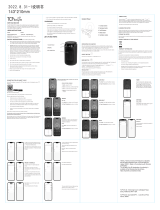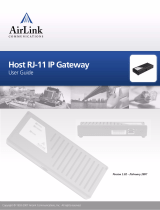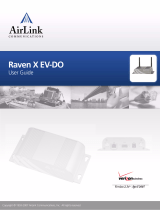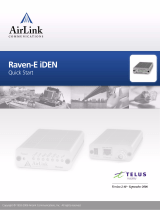Campbell Scientific Raven110 GPRS/EDGE Digital Cellular Modem Owner's manual
- Category
- Networking
- Type
- Owner's manual
This manual is also suitable for

Raven110 GPRS/EDGE
AirLink Cellular Modem
Revision: 12/07
Copyright © 2006-2007
Campbell Scientific, Inc.

Warranty and Assistance
The RAVEN110 GPRS/EDGE MODEM is warranted by CAMPBELL
SCIENTIFIC, INC. to be free from defects in materials and workmanship
under normal use and service for twelve (12) months from date of shipment
unless specified otherwise. Batteries have no warranty. CAMPBELL
SCIENTIFIC, INC.'s obligation under this warranty is limited to repairing or
replacing (at CAMPBELL SCIENTIFIC, INC.'s option) defective products.
The customer shall assume all costs of removing, reinstalling, and shipping
defective products to CAMPBELL SCIENTIFIC, INC. CAMPBELL
SCIENTIFIC, INC. will return such products by surface carrier prepaid. This
warranty shall not apply to any CAMPBELL SCIENTIFIC, INC. products
which have been subjected to modification, misuse, neglect, accidents of
nature, or shipping damage. This warranty is in lieu of all other warranties,
expressed or implied, including warranties of merchantability or fitness for a
particular purpose. CAMPBELL SCIENTIFIC, INC. is not liable for special,
indirect, incidental, or consequential damages.
Products may not be returned without prior authorization. The following
contact information is for US and International customers residing in countries
served by Campbell Scientific, Inc. directly. Affiliate companies handle
repairs for customers within their territories. Please visit
www.campbellsci.com to determine which Campbell Scientific company
serves your country. To obtain a Returned Materials Authorization (RMA),
contact CAMPBELL SCIENTIFIC, INC., phone (435) 753-2342. After an
applications engineer determines the nature of the problem, an RMA number
will be issued. Please write this number clearly on the outside of the shipping
container. CAMPBELL SCIENTIFIC's shipping address is:
CAMPBELL SCIENTIFIC, INC.
RMA#_____
815 West 1800 North
Logan, Utah 84321-1784
CAMPBELL SCIENTIFIC, INC. does not accept collect calls.

Raven110 Table of Contents
PDF viewers note: These page numbers refer to the printed version of this document. Use
the Adobe Acrobat® bookmarks tab for links to specific sections.
1. General Description.....................................................1
2. Establish Cellular Service...........................................1
2.1 Raven110 Cellular Coverage/Service Requirements................................1
3. Specifications ..............................................................2
3.1 Raven110 Specifications ..........................................................................2
4. Configuration...............................................................3
4.1 Base Station Requirements for Raven110 ................................................3
4.2 Datalogger Site Equipment.......................................................................3
4.3 Power Considerations...............................................................................6
5. Program the Raven110 Modem ..................................7
5.1 Using Wireless Ace 3 G to Configure the Modem...................................7
5.2 Dynamic IP Address...............................................................................10
6. LoggerNet/PC400W Software Setup ........................11
7. Troubleshooting ........................................................12
7.1 Check the Modem Configuration ...........................................................12
7.2 Verify Connections at the Datalogger ....................................................15
7.3 LoggerNet/PC400W Device Map...........................................................15
7.4 Using Wireless Ace 3G to Check Modem Communications with
Datalogger.................................................................................................16
Appendices
A. Wireless Ace Setup without Template File...........A-1
B. Installation of SIM Card in the Raven110.............. B-1
C. Configuring the Raven for PPP..............................C-1
D. Understanding APNs ..............................................D-1
i

Raven110 Table of Contents
ii
Figures
4.2-1. Modem Interface Options.................................................................... 4
4.2-2. Antennas for Use with the Raven Modems......................................... 6
7-1. Wireless Ace status page showing communications with modem ....... 17
B-1. Modem Back...................................................................................... B-1
B-2. Modem Partially Slid from Case........................................................ B-1
B-3. Tray Button........................................................................................ B-2
B-4. Empty SIM Tray................................................................................ B-2
B-5. SIM Tray with a SIM......................................................................... B-2
B-6. Inserting the SIM ............................................................................... B-2

Raven110 GPRS/EDGE AirLink Cellular
Modem
1. General Description
This manual provides information for interfacing the AirLink Raven110
cellular modem to Campbell Scientific dataloggers. An AirLink CD ships with
the modem that includes AirLink manuals and software utilities. AirLink
manuals referenced in this manual include:
WirelessAce3G_UserGuide2.00.pdf
AT&T/Cingular_EDGE-GPRS_Raven_UserGuide2.20.pdf
AT&T/Cingular_EDGE-GPRS_Raven_QSG2.01.pdf
The Raven110 digital cellular modem is manufactured by AirLink for use on
the AT&T/Cingular General Packet Radio Service (GPRS) network. The
modem is accessed through the Internet using TCP/IP communications
protocol using a Static or Dynamic IP address.
• A Static IP address is permanently assigned to a particular account and
will always be used whenever the Raven connects to the Internet.
• A Dynamic IP address is assigned on a “need to have” basis. A dynamic
IP address is used with a service such as IP Manager (Section 5) to
translate a dynamic IP address to a domain name, so that the Raven can be
contacted as if it had a static IP.
An AT&T/Cingular GPRS account can be setup for a Static or Dynamic IP
address.
2. Establish Cellular Service
2.1 Raven110 Cellular Coverage/Service Requirements
What you need:
AT&T/Cingular GPRS/EDGE coverage at the datalogger site (for a coverage
map refer to:
http://www.Cingular.com/refresh/common/estore_zipcode_maps
).
GPRS account established with AT&T/Cingular.
To setup an account with AT&T/Cingular:
Call (1-800-331-0500) and ask for the “Data Plan”. Select from three plan
options:
5 Meg $19.99/month
10 Meg $29.99/month
Unlimited $59.99/month
When setting up the account, ask to have “Feature Code G821” added to the
account. Feature Code G821 configures the account for the “Internet” Access
1

Raven110 GPRS/EDGE AirLink Cellular Modem
Point Name (APN), and the device to “Mobile Terminated”, which makes the
modem accessible by LoggerNet over the internet. If Feature Code G821 was
not added when the account was setup, it can be added later. The APN name
must also be programmed into the modem (Section 5.1). See Appendix D for
additional APN information.
AT&T/Cingular will provide a SIMM card for each modem. In some cases the
SIM can be picked up at a local AT&T/Cingular store. The SIMM card must
be installed inside of the modem as described in Appendix B.
AT&T/Cingular can also setup a Custom APN. A Custom APN takes 4-6
weeks to setup and costs about $1000. A Custom APN may offer more
efficient routing and better security than a standard Internet APN, and should
be considered for large cellular phone networks.
3. Specifications
3.1 Raven110 Specifications
AirLink Raven Model G3210 GPRS-EDGE modem
Network: 1900/850 MHz
Transmit Frequency: 1850-1910 MHz and 824-849 MHz
Transmit Power: 1.0 W for 1900 MHz; 2.0 W for 850 MHz
Receiver Frequency: 1930-1990 MHz and 869-894 MHz
Modes Supported: GPRS and SMS
Throughput: up to 40 kbps
RS-232 Data Rates: 1200 bps to 115.2 kbps
Input Voltage: 10 to 28 Vdc
Input Current: 20 to 250 mA
Typical Current Drain at 12 Vdc: 20 mA dormant connection (idle for 10 to 20
seconds), 130 mA transmit/receive
Operating Temperature Range: -30° to +70°C (10% duty cycle limit above
60°C)
Operating Humidity: 5% to 95% non-condensing
Serial Protocols: AT Commands, PPP, SLIP, UDP, TCP
Serial Interface: RS-232
RF Antenna Connector: 50 Ohm TNC
Status LEDs: Power, Channel Acquired, Link Status, Network Registration,
RSSI, Transmit/Receive, Block Errors
Dimensions: 3"W x 1"D x 5.1"L (5.8"L w/connector), 7.6 W x 2.5 D x
13 L cm (14.7 L cm w/connector)
Weight: <1 lb (<0.5 kg)
2

Raven110 GPRS/EDGE AirLink Cellular Modem
4. Configuration
4.1 Base Station Requirements for Raven110
PC running Campbell Scientifics’ LoggerNet or PC400 software, with access
to the internet.
4.2 Datalogger Site Equipment
• Raven modem with power cable (included with modem).
• Datalogger—21X, CR510, CR10(X), CR23X, CR7, CR1000, CR5000,
CR3000, CR800.
• SC105 or SC932A Interface—connects the modem to the 21X, CR510,
CR10(X), CR7, or other dataloggers’ CS I/O port.
If you have a black SC12 cable that is not Rev 1 or newer (as
indicated on cable), it is a CS I/O cable only and will not work
for RS-232. Connect the black SC12 cable between the
datalogger and the SC932A. Use a 9-pin serial cable or a blue
ribbon cable between the phone and the SC932A.
NOTE
• PN 18663 Null Modem Cable—connects the modem to the CR23X,
CR3000, CR800, CR2XX, CR1000 or CR5000 RS-232 port.
3

Raven110 GPRS/EDGE AirLink Cellular Modem
SC105 interface connects the modem to a datalogger’s CS I/O port;
recommended for dataloggers with the PakBus Operating System.
SC932A interface connects the modem to the CS I/O port;
recommended for dataloggers with the Mixed-Array Operating System.
PN 18663 null modem cable connects the modem to a datalogger's
RS-232 port (not compatible with the 21X, CR510, CR10X,
or CR7 dataloggers).
FIGURE 4.2-1. Modem Interface Options.
4

Raven110 GPRS/EDGE AirLink Cellular Modem
• PN 13493 Raven Mounting Kit—includes mounting hardware for securing
the modem to below referenced environmental enclosure and a 9-pin male
to 9-pin female cable.
• Antenna—the following antennas are available from Campbell
Scientific. Contact a Campbell Scientific Applications Technician for
help in determining the best antenna for your application.
o The 18285 1 dBd omnidirectional antenna. This antenna is dual
band, covering both the 800 MHz and 1.9 GHz bands, and is
strongly recommended where cellular coverage is strong. The
18285 includes 10 feet of cable fitted with a TNC male connector
for attachment to the Raven, and a mount/u-bolt assembly for
attaching the antenna to a mast, post, or crossarm up to 1.5" (3.8
cm) in diameter.
o The 14454 9dBd Yagi Antenna is a higher gain antenna that
should be "aimed" at the service provider's antenna. The 14454
includes 10 feet of cable fitted with a TNC male connector for
attachment to the GPRS modem, and a bracket/u-bolt assembly
for attaching the antenna to a mast or post. This antenna is
recommended for fringe areas that require a higher gain antenna.
o The 14453 Half-Wave Dipole Whip Antenna is a lower gain
antenna used in transmitting short distances. It is an 800 MHz
cellular antenna that terminates in a TNC Female connector for
attachment to the Redwing modem. This antenna is intended for
use inside the enclosure. Please note that the backplate of the
enclosure is a grounded plane. If it is interposed between the
antenna and the cell tower, it may attenuate the strength of the
transmission signal. Simply turning the enclosure 90 to 180
degrees on its mounting mast may solve weak transmission
issues.
5

Raven110 GPRS/EDGE AirLink Cellular Modem
PN 18285 1 dBd Omni Directional Antenna
PN 14454 9dBd Directional Yaggi Antenna
PN 14453 Half-Wave Dipole Whip Antenna
FIGURE 4.2-2. Antennas for Use with the Raven Modems
• Power Supply (see power considerations).
• Environmental Enclosure— ENC 10/12, ENC 12/14, or ENC 16/18.
4.3 Power Considerations
• A power cable included with the modem connects to the datalogger's 12 V
or switched 12 V terminal. Connection to the switched 12 V terminal
allows the datalogger to switch power to the modem during scheduled
transmission intervals if desired.
• When using the switched 12 V terminal, the modem can typically be
powered with a BP12 battery, CH100 charger/regulator, and MSX10 solar
panel.
6

Raven110 GPRS/EDGE AirLink Cellular Modem
5. Program the Raven110 Modem
The following software is used to program the modem:
AirLink’s Wireless Ace 3G software utility, which is used to configure settings
in the modem and to load the GPRS/EDGE template file. The Wireless Ace
3G utility can be found on the CD included with the modem, or can be
downloaded from AirLink’s website: www.airlink.com/support
.
Campbell Scientific’s “Raven GPRS/EDGE Template 115200” file for
dataloggers that support 115200 baud (e.g. CR1000), or “Raven GPRS/EDGE
Template 9600” file for dataloggers that support a maximum baud rate of 9600
(e.g. CR10X). The template file configures the modem to be compatible with
CSI dataloggers. The template files are available from Campbell Scientific’s
Website: www.campbellsci.com/downloads
.
5.1 Using Wireless Ace 3G to Configure the Modem
To install Wireless Ace 3G from the AirLink CD, click on the “Wireless ACE
3G” link under “Modem Utilities” and follow the prompts. Once the
application has been installed, it can be run from the Windows Start menu or
from the icon on the desktop.
Connect the Raven to a serial RS232 port on the PC with a direct RS-232
cable. Also connect the antenna, and 12 V power.
Run Wireless Ace 3G to get the following screen:
7

Raven110 GPRS/EDGE AirLink Cellular Modem
Click the Connect icon in the Configuration Panel to open the connection
options dialogue box. Select PPP, and the COM port the modem is connected
to. Do not change the Password (the default password is 12345). Click OK to
continue.
Click the Load icon in the Configuration panel. When prompted for a template
file name, select “ravengprs_115200.xml” for dataloggers that support 115200
baud (e.g. CR1000), or “ravengprs_9600.xml” for dataloggers that support a
maximum baud rate of 9600 (e.g. CR10X). The template file configures the
modem to be compatible with CSI dataloggers. Template files are available
from Campbell Scientific’s Website: www.campbellsci.com/downloads
.
8

Raven110 GPRS/EDGE AirLink Cellular Modem
Baud rate can be changed from 9600, to a higher baud rate
supported by the datalogger (e.g., 115200 for a CR1000).
NOTE
Click on EDGE/HSDPA Group to get the following screen:
An AT&T/Cingular account with Feature Code G821 is configured for an
Access Point Name (APN) = “internet”. Enter “internet” in the New Value
field for “*NETAPN” and “1,IP,internet” in the New Value field for
+CGDCONT.
9

Raven110 GPRS/EDGE AirLink Cellular Modem
For a custom APN, or APN through a third party provider (e.g. Crossbridge
Solutions), enter the APN as shown in the following screen. The example is
for an APN = “gprs02.Motient.net”.
After the template file has been loaded, and the APN entered, click the Write
icon to save the changes in the modem
.
Click the Reset icon to restart the modem. The other ways to reset the modem
are by pressing the reset button on the front of the modem or removing the
power from the modem.
Click the Disconnect icon to terminate communications with the modem.
Unless you click the Write command, changes made in the New
Value field will not be sent to the modem. For some changes
(e.g., baud rate) you must also Reset the modem before the
changes will take effect.
NOTE
5.2 Dynamic IP Address
“Data Plan” accounts setup through AT&T/Cingular are provided with a
Dynamic IP address. Dynamic IP addresses are granted only when the modem
is connected and can change each time the modem reconnects to the network.
AT&T/Cingular offers a free Dynamic DNS service that translates a dynamic
IP address to a fully qualified domain name, so that the modem can be
contacted by name as if it had a Static IP.
The domain name used by LoggerNet is: 1xxx.internet.mycingular.com, where
“xxx” is the 10-digit MSISDN associated with the account, and
“internet.mycingular.com” is AT&T/Cingular’s DDNS. No “Dynamic IP”
modem settings are required when using AT&T/Cingular’s DDNS service.
10

Raven110 GPRS/EDGE AirLink Cellular Modem
6. LoggerNet/PC400W Software Setup
The Device Map is configured from the “Setup” button on the
LoggerNet/PC400W Toolbar. Configure the Device Map as described below.
1. Select Add Root | IPPort.
2. Add a datalogger to the IPPort (PakBus dataloggers, e.g. the CR1000,
require a PakBusPort).
3. On the IPPort page, add the IP address/domain name and the Port number
(the Raven template file configures the port to be 3001).
4. For PakBus dataloggers, leave the default settings on the PakBusPort page
(Extra Response Time may be needed).
5. For PakBus dataloggers, set the PakBus address to match that of the
datalogger (default address in the datalogger is 1).
LoggerNet Device Map
Preceding zeros are not entered in the Internet IP Address (e.g.
070.218.074.247 is entered as 70.218.74.247).
NOTE
11

Raven110 GPRS/EDGE AirLink Cellular Modem
7. Troubleshooting
If LoggerNet/PC400W software is unable to establish a connection with the
modem:
7.1 Check the Modem Configuration
Check the GPRS cellular account information, and verify there is GPRS
coverage at the site. Dynamic IP accounts require a Dynamic Domain Name
Server (DDNS) (Section 5).
If the cellular account is with CrossBridge Solutions, then CrossBridge’s
tunnel software must be running on the host computer for communications to
be established with the datalogger.
12

Raven110 GPRS/EDGE AirLink Cellular Modem
The modem has to be configured using Wireless Ace 3G as described in
Section 5.
Modem settings have to be changed, and the APN number entered, using
Wireless Ace 3G (Section 5). After the Raven GPRS template file has been
loaded, you can verify settings in the Status, Misc, Serial, and GPRS groups
have been configured as shown below.
Network State should be “Network Ready”. Signal strength (RSSI) should be -
60 to -85. The IP address will change for Dynamic IP accounts.
13

Raven110 GPRS/EDGE AirLink Cellular Modem
The Device Port gets changed from the default 12345 to 3001 when the
template file is loaded into the modem (Section 5). The Device Port number
gets entered with the IP address in LoggerNet (Section 6).
The “Raven GPRS/EDGE Template 9600” template file sets the baud rate to
9600, which is the maximum baud rate for the CR10X and older dataloggers.
For newer dataloggers, the baud rate can be changed to the highest baud rate
supported by the datalogger (e.g. 115200 baud for the CR1000).
If an SC105 interface is used, its default baud rate of 9600 will have to be
changed to match the baud rate of the modem (using CSI’s DevConfig utility).
Baud rate changes require the modem to be reset before the
change takes affect. Click the Reset icon in Wireless Ace to the
reset the modem and implement the change.
NOTE
14

Raven110 GPRS/EDGE AirLink Cellular Modem
Verify the APN has been entered in the NETAPN and +CGDCONT fields as
shown above (where gprs02.Motient.net is the APN).
7.2 Verify Connections at the Datalogger
Verify the modem is connected to 12 V and the Pwr led is on (green).
Check the Reg light on the modem. The Reg light should be solid green,
which indicates the modem is registered with the cellular network.
Make sure the antenna is properly connected and oriented. Signal strength
should be the -60 to -80.
An SC932A or SC105 interface is required to connect the modem to a
datalogger’s CSI/O port. The default settings for SC105 can be used with the
Raven110 when the modem is configured for 9600 baud (baud rate set by the
template file). If the baud rate is changed in the modem, the baud rate in the
SC105 will have to be changed to match that of the modem (SC105 settings
can be changed using CSI’s DevConfig utility).
Make sure the modem is connected to the “DCE Device” connector on the
SC932A, or the “Modem” connector on the SC105.
A null modem cable is required to connect the modem to a datalogger’s
RS-232 port. No other interface is required.
7.3 LoggerNet/PC400W Device Map
The IP address and Device Port settings are entered in LoggerNet as described
in Section 6.
Make sure the port number at the end of the IP address matches the port
number of the modem. The template file sets the port number to 3001.
15

Raven110 GPRS/EDGE AirLink Cellular Modem
Try adding a few seconds (no more than five seconds) of extra response time to
the datalogger or PakBus port.
For a PakBus datalogger, verify the PakBus address in the setup screen
matches that of the datalogger.
For networks with multiple PakBus ports, uncheck the ‘PakBus Port Always
Open’ options on all PakBus ports.
7.4 Using Wireless Ace 3G to Check Modem Communications
with Datalogger
The modem’s “Host Serial Bytes Sent” and “Host Serial Bytes Received”
windows can indicate whether or not the modem is communicating with the
datalogger.
Establish a connection with the modem through the cellular network using
Wireless Ace (click on the Modem menu item, Connect, UDP. Enter the IP
address, and click OK). Go to the Status group and note the “Host Serial Bytes
Sent” and “Host Serial Bytes Received” values (Figure 7-1). Try connecting
with the datalogger using LoggerNet/PC400W. If a connection cannot be
established, close LoggerNet and reconnect with Wireless Ace and compare the
current values with the previous values.
If the values are the same, the modem is not attempting to make a connection
with the datalogger. Check that the Raven GPRS template file has been
loaded.
If the “Host Serial Bytes Sent” increased, the modem attempted to connect to
the datalogger, but the response from the datalogger did not make it back to the
modem. Check the interface between the modem and the datalogger.
If both values incremented, the modem and the datalogger are communicating.
Try adding some extra response time in LoggerNet.
Baud rate changes require the modem to be reset before the
change takes affect. Click the Reset icon in Wireless Ace to the
reset the modem and implement the change.
NOTE
16
Page is loading ...
Page is loading ...
Page is loading ...
Page is loading ...
Page is loading ...
Page is loading ...
Page is loading ...
Page is loading ...
Page is loading ...
Page is loading ...
Page is loading ...
Page is loading ...
Page is loading ...
Page is loading ...
Page is loading ...
Page is loading ...
Page is loading ...
Page is loading ...
-
 1
1
-
 2
2
-
 3
3
-
 4
4
-
 5
5
-
 6
6
-
 7
7
-
 8
8
-
 9
9
-
 10
10
-
 11
11
-
 12
12
-
 13
13
-
 14
14
-
 15
15
-
 16
16
-
 17
17
-
 18
18
-
 19
19
-
 20
20
-
 21
21
-
 22
22
-
 23
23
-
 24
24
-
 25
25
-
 26
26
-
 27
27
-
 28
28
-
 29
29
-
 30
30
-
 31
31
-
 32
32
-
 33
33
-
 34
34
-
 35
35
-
 36
36
-
 37
37
-
 38
38
Campbell Scientific Raven110 GPRS/EDGE Digital Cellular Modem Owner's manual
- Category
- Networking
- Type
- Owner's manual
- This manual is also suitable for
Ask a question and I''ll find the answer in the document
Finding information in a document is now easier with AI
Related papers
-
Campbell Scientific Raven100 CDMA Cellular Modem Owner's manual
-
Campbell Scientific SC932A 9-Pin to 9-Pin RS-232 Interface Owner's manual
-
Campbell Scientific LoggerNet Owner's manual
-
Campbell Scientific LoggerNet Owner's manual
-
Campbell Scientific SC105 Owner's manual
-
Campbell Scientific CC5MPX and CC5MPXWD Owner's manual
-
Campbell Scientific LoggerNet Owner's manual
-
Campbell Scientific LoggerNet Owner's manual
-
Campbell Scientific LoggerNet Owner's manual
-
Campbell Scientific Redwing 105 Owner's manual
Other documents
-
 TCP Smart WiFi Heater Fan Operating instructions
TCP Smart WiFi Heater Fan Operating instructions
-
Hypercom M4230 User manual
-
Campbell Airlink Raven XT-Telus User manual
-
AirLink Raven GPRS User manual
-
ACE MOBILE POCKET WI-FI Quick start guide
-
 AirLink Communications RJ-11 User manual
AirLink Communications RJ-11 User manual
-
Sony VGN-T340P Overview
-
 AirLink Communications X EV-DO User manual
AirLink Communications X EV-DO User manual
-
AirLink Version 2.40 User manual
-
 AirLink Communications Version 2.40 User manual
AirLink Communications Version 2.40 User manual









































